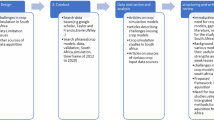Abstract
A crop simulation model must first be capable of representing the actual performance of crops grown in any region before it can be applied to the prediction of climate variability and change impacts. A cropping systems model (CropSyst) simulations of crop productivity in the sub-Saharan Central African (using Cameroon as the case study) region, under the current climate were compared with observed yields of maize, sorghum, groundnut, bambara groundnut and soybean from eight sites. The model produced both over-and-under estimates, but with a mean percentage difference of only –2.8%, ranging from –0.6% to –4.5%. Based on these results, we judged the CropSyst simulations sufficiently reliable to justify use of the model in assessing crop growth vulnerability to climatic changes in Cameroon and else where.

Similar content being viewed by others
Reference
Abraha MG, Savage MJ (2006) Potential impacts of climate change on the grain yield of maize for the midland of Kwazulu-Natal, South Africa. Agric Ecosys Environ 115:150–160
AGRISTAT (2001) Semi-annual bulletin of the statistics of agricultural sector 2000/2001, DEPA, Ministry of Agriculture. Yaounde, Cameroon
Badini O, Stöckle CO, Franz EH (1997) Application of crop simulation modelling and GIS to agroclimatic assessment in Burkina Faso. Agric Ecosys Environ 64:233–244
Badini O, Stöckle CO, Jones JW, Nelson R, Kodio A, Keita M (2007) A simulation-based analysis of productivity and soil carbon in response to time-controlled rotational grazing in the West African Sahel region. Agric Syst 94:87–96
Batjes N (1995) A homogenised soil data file for global environmental research: a subset of FAO, ISRIC and NRCS profiles (version 1.0). Working paper 95/10, International Soil Reference Information Center (ISRIC), Wageningen, The Netherlands
Brassard JE (2003) Valuation des impacts de la hausse de la concentration atmospherique du CO2 et des changements climatiques sur la production agricole du Quebec. Me‘moire de Maitrise, Departement de Geographie, Universite de Montreal, QC, 193 pp
DeLancey M, Mike D (2000) Historical dictionary of the Republic of Cameroon, 3rd edn. Scarecrow, Lanham, MD
Farre I (1998) Maize (Zea mays L.) and sorghum (Sorghum bicolor L. Moench) response to deficit irrigation. Agronomy and Modelling, PhD Thesis, University of Lieida, Spain, 150 pp
Fischer G, Shah M, Tubiello F, Van Velthuizen HT (2005) Socio-economic and climate change impacts on agriculture: an integrated assessment, 1990–2080. Philos Trans Roy Soc B 360:2067–2083
IPCC (2007) Working Group II Contribution to the Intergovernmental Panel on Climate Change Fourth Assessment Report: Climate Change 2007: impacts, adaptation and vulnerability. Brussels, Belgium
Molua EL (2003) Global climate change and Cameroon’s Agriculture: evaluating the economic impacts. PhD Thesis, Institute of Agricultural Economics, Georg-August University, Goettingen, Germany, 94 pp
Moriondo M, Maselli F, Bindi M (2007) A simple model of regional wheat yield based on NDVI data. Eur J Agron 26:266–274
Ndemah RN (1999) Towards an integrated crop management strategy for the African stalk borer Busseola fusca (Fuller) (Lepidoptera: Noctuidae) in maize systems in Cameroon. PhD Thesis, University of Hannover, Hannover, Germany, 145 pp
Neba A (1999) Modern geography of the Republic of Cameroon, 3rd edn. Neba, Bamenda, Cameroon
Priestly CHB, Taylor RJ (1972) On the assessment of surface heat flux and evaporation using large-scale parameters. Mon Weather Rev 100:81–82
Richards LA (1931) Capillary conduction of liquids in porous mediums. Physics 1:318–333
Ritchie JT, Singh U, Godwin DC, Bowen WT (1998) Cereal growth, development and yield. In: Tsuji GY, Hoogenboom G, Thornton PK (eds) Understanding options for agricultural production. Kluwer, Dordrecht, pp 79–98
Rivington M, Matthews KB, Bellocchi G, Buchan K, Stöckle CO, Donatelli M (2006) An integrated assessment approach to conduct analyses of climate change impacts on whole-farm systems. Environ Model Softw 22:202–210
Rosenzweig C, Hillel D (1998) Climate change and the global harvest. PBD: 1998. United States, Oxford University Press, New York, 323 pp
Stöckle CO, Donatelli M, Nelson R (2003) CropSyst, a cropping systems simulation model. Eur J Agron 18:289–307
Thornton PK, Jones PG (2003) The potential impacts of climate change on maize production in Africa and Latin America in 2055. Glob Environ Change 13:51–59
Thornton PK, Jones PG, Owiyo TM, Kruska RL, Herero M, Kristjanson P, Notenbaert A, Bekele N (2006) Mapping climate vulnerability and poverty in Africa. Report to the Department for International Development, ILRI, Nairobi, Kenya, 200 pp
Tingem M, Rivington M, Azam Ali SN, Colls JJ (2007) Assessment of the ClimGen stochastic weather generator at Cameroon sites. Afr J Environ Sci Technol 1:86–92
Tingem M, Rivington M, Azam Ali SN, Colls JJ (2008) Climate variability and maize production in Cameroon: simulating the effects of extreme dry and wet years. Singapore J Trop Geogr (in press)
Worldbank (2007) World Development Indicators Database. Avaliable at http://devdata.worldbank.org/. Cited 24 December 2007
World Fact Book (2007) (Cameroon): United States Central Intelligence Agency (CIA). Aavailable at https://www.cia.gov/library/publications/the-world factbook/geos/cm. Cited 9 December 2007
Acknowledgements
We acknowledge the help and assistance provided by Claudio O. Stöckle and Roger L. Nelson (Biological Systems Engineering Department, Pullman WA, USA) in using CropSyst.
Author information
Authors and Affiliations
Corresponding author
Rights and permissions
About this article
Cite this article
Tingem, M., Rivington, M., Bellocchi, G. et al. Crop yield model validation for Cameroon. Theor Appl Climatol 96, 275–280 (2009). https://doi.org/10.1007/s00704-008-0030-8
Received:
Accepted:
Published:
Issue Date:
DOI: https://doi.org/10.1007/s00704-008-0030-8




